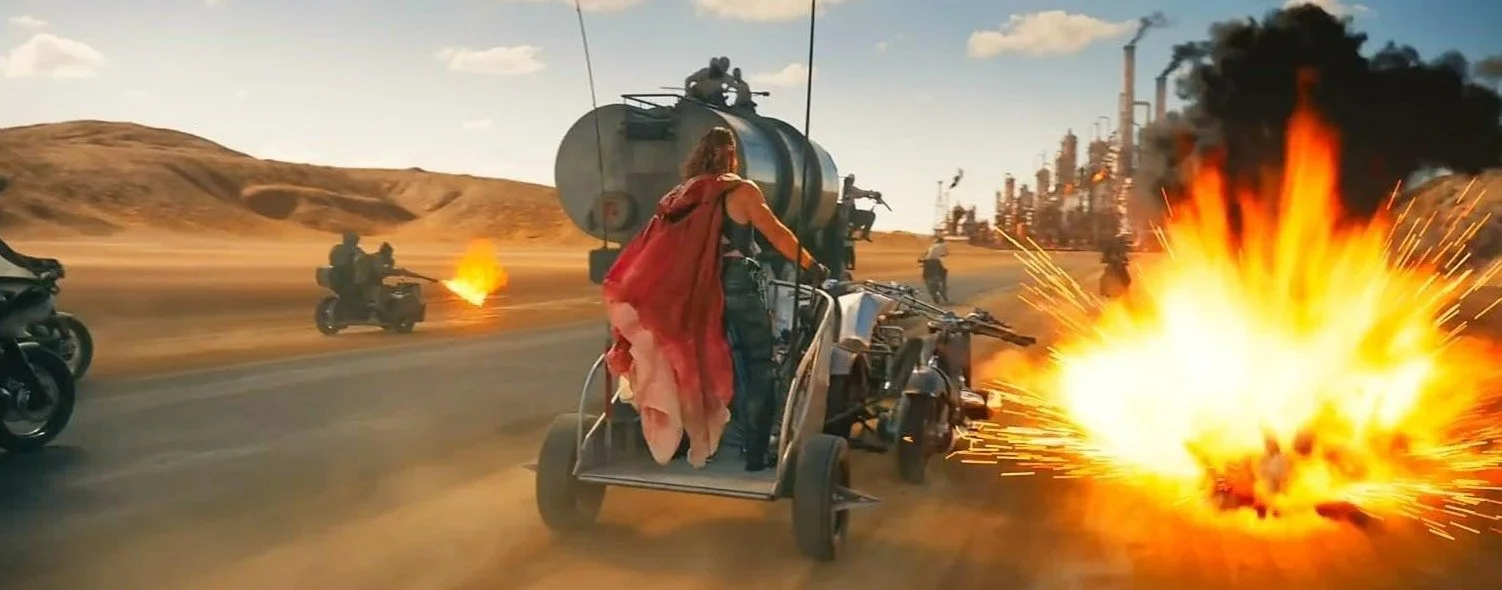Furiosa: A Mad Max Saga review
Director: George Miller
Writers: George Miller & Nico Lathouris
Stars: Anya Taylor-Joy, Chris Hemsworth, Tom Burke & Alyla Browne
Running Time: 148 minutes
Please note there may be spoilers below.
The biggest sin Furiosa: A Mad Max Saga commits is not being Mad Max: Fury Road. Instead of reveling in chaotic simplicity, George Miller’s newest entry in the franchise is surprisingly episodic, right down to the title cards that announce each of its five acts, each one almost self-contained as short, often breathtaking action beats that shape the life of a fascinating character. To use a literary analogy, if Fury Road is the great Australian novel, Furiosa feels more like a short story collection set within the same universe. It’s an entirely enjoyable artistic feat, but it’s often an unnecessary reminder of a better experience.
At 79 years old, director George Miller has the right to slow down, but it’s a tribute to him that Furiosa: AMMS has the same boundless energy we’ve come to expect. This desert is still full of outlandish vehicular combat, playfully imagined and deftly organised, and if it was ever in doubt, Furiosa: AMMS cements Miller’s status as the master of wheel carnage. The combination of small (the stab of a knife) and large (panoramic wide of The War Rig truck during assault) jolts our adrenaline in ways seldom felt in other car chases. When it comes to cinematic action, it’s not so much that Miller is playing on a different level; he’s playing an entirely different game.
Anya Taylor-Joy inhabits a young Furiosa with a wide-eyed sensitivity, a woman fighting for freedom in the Wasteland that provides very little. Partially absent of Charlize Theron’s charisma, Taylor-Joy gets somewhat lost in the largely silent role of Furiosa with a script that removes the big emotions and replaces them with fiendish horizon-staring and much heavy breathing. Ironically for a movie hell-bent on developing a character’s origins, Furiosa feels emotionally flatter this time around. She’s effective, but often undercut by an episodic script that fails to give her emotional catharsis.
Yet her growth remains interesting. The first two acts are an extended look at Furiosa’s childhood, detailing the cruelty of the world presented to her and the tragedy of being born in a female paradise but being raised in a testosterone hell. Disguised as boy, shaving her head, she evades the cruel death of a slave by working her way under the wing of Praetorian Jack (Tom Burke), a composite father/love-interest figure who teaches her the skills to survive. Thankfully we are spared the details of the lessons, and instead cut straight to a fully skilled Furiosa by Act 3, where we’re presented with the biggest, most complex set piece of the film. By then I was thanking my lucky stars I didn’t have to watch a montage of Furiosa being taught how to fight.
Unfortunately this underlines the film’s core redundancy, the same redundancy that makes prequels not only risky but inherently useless – that is, if the original movie did its job well enough, then no further explanation is needed to convey who the characters are.
The biggest reason I find Charlise Theron so captivating in Fury Road is because her background is completely implicit in that story. Within minutes of her appearance, what’s so wonderful about her performance is that the audience can already imagine her tragic history, her loss, her reason to lust for blood. The substance of Furiosa: AMMS is so inherent in the DNA of the previous entry, it would feel difficult not to argue its very existence feels superfluous. There are such masterful moments of high cinema here, but oddly the foundations of the piece struggle to provide it a reason to be.
Gender division was such a great component in Fury Road – the story of saving of women from being ‘breeders’ for villain Immortant Joe. In nearly all aspects, it’s Furiosa’s movie, more than Mad Max’s, since the primary character arc is hers. In the details of Fury Road, you can almost see George Miller’s frustration at not being able to make the entire movie about her. And now that he’s got the chance to tell her story, I couldn’t help but feel disappointed that the gender struggle wasn’t a more prominent component. In Furiosa: AMMS, by the time she’s an adult, Furiosa is openly feminine, openly herself, which seems contradictory to her need to hide as a younger teenager. I almost felt a craving to have her character arc be about her journey to become herself, rather than her be a fully formed, confident woman. Given the world she was raised in, and the misogynistic thread of the gangs that rule it, I find it odd the film isn’t interested in exploring how she becomes a woman in a world that seemingly won’t let her.
A quick word on Chris Hemsworth. It’s probably his best role. He disappears behind the nose prosthetic and bogan accent and inhabits villain Dementus as a warlord leader who seems as surprised as anyone that he’s in charge. Rather than channeling unadulterated cruelty for the sake of it, he instead plays a man incapable of being anything other than cruel because this was the cards he was dealt. He’s obscene, hard-headed, and strangely human in a world full of comic-book characters. In a merciful act of restraint, he also manages to avoid turning Dementus in a dreaded modern caricature, a figure made of meme-inspiring material. By the end, we are left with a pathetic man who runs simply on his instinct for power. There’s a political allegory in there somewhere.
If you can embrace this movie as an unneeded explainer for a character that needed no explanation, what remains is some of cinema’s most audacious spectacle wrapped in a story that isn’t fully stitched together.
